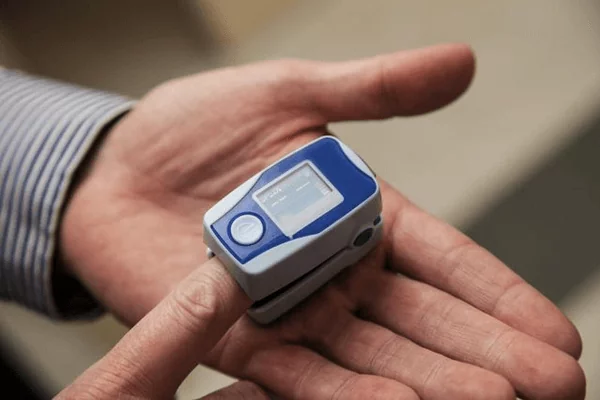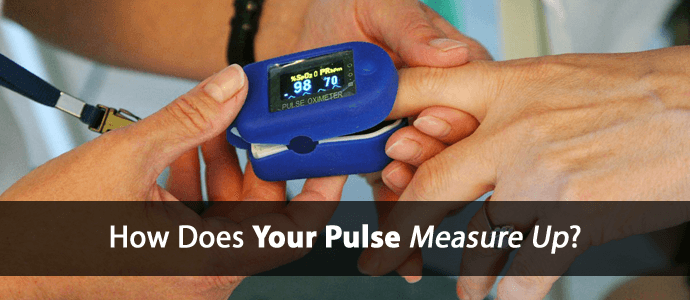Has this ever happened to you?
Your phone rings and it’s the receptionist from your doctor’s office. Your thyroid labs results are in and your doctor wants to go over them.
Fast forward a few days and you’re sitting with your doctor anticipating the results.
Then you hear those words…
“Great news! Everything came back normal, so there’s nothing to worry about.”
Great news for whom?
You’re left struggling with your thyroid symptoms and with nowhere to turn.
Well, that about sums up the experience of many of my clients.
Why?
Because blood tests for thyroid function are inaccurate and unreliable for most.
Today, I’ll show you how to use a simple test, the thyroid pulse test, to check your own thyroid. I’ll also show what to aim for, for a healthy pulse rate, but first…
Why Thyroid Labs Are So Inaccurate
Thyroid lab tests can be very deceiving.
They are notorious for missing true diagnoses. This leaves a large percentage of thyroid sufferers undiagnosed and improperly treated.
There are many reasons for this.
For starters, the lab reference ranges are not accurate.
And blood labs can’t tell you if thyroid hormone is getting to your cells or if your cells are able to use it.
(NOTE: Want to put an end to your hypothyroidism for good? See what’s stopping your cells from using thyroid in this article on Unblocking Your Thyroid Hormone Pathway.)
This is why many have turned to more accurate and reliable testing methods such as basal body temperature testing.
Your body temperature is very useful, but comes with a few limitations of its own.
This is why I use a special testing protocol with my clients to better account for these limitations.
(Note: Want to use the same testing protocol I use with my clients? Use my “Ultimate Thyroid Testing Protocol”. It’s more accurate, won’t cost you a dime, and can easily be done from home in five minutes or less. Get the step-by-step guide and worksheets while I walk you through it all. Just click here.)
The Limitation of Thyroid Temperature Testing (Alone)
We’re now into August.
In many parts of the northern hemisphere, outside temperatures are blazing.
And a warmer outside temperature will influence your body temperature.
The warmer your environment, the easier it is to maintain a higher body temperature.


It’s like taking your temperature while you sit in a hot tub or sauna.
Your body doesn’t have to produce much energy to maintain this higher temperature.
So, your temperature will rise regardless of your poor thyroid function.
This is why it’s best to use an additional testing method that is not influenced by temperature.
And this is where your pulse becomes very important.
What Your Pulse Can Tell You About Your Thyroid
Using your pulse to measure thyroid function was originally the idea of Dr. Raymond Peat.
It came to him after observing hypothyroid people during the summer. They maintained close to normal body temperatures, while still showing obvious thyroid symptoms.
Yet, unlike body temperature, pulse isn’t influenced by your environmental temperature.
So, he began accounting for pulse rate to help confirm the accuracy of body temperature testing.
And what he found was that their pulse was quite low.
A low pulse rate between 50 to 70 bpm (beats per minute) is a sign of poor metabolism and hypothyroidism.
Many of my clients have reported feeling better with an increased pulse rate.
Yet, it’s also important to confirm that your pulse rate is truly healthy. Oftentimes it becomes artificially elevated by stress hormones.
Being hypothyroid, your body naturally over-produces stress hormones.
And when the stress hormone adrenaline rises, your pulse will oftentimes rise with it.
This can trick you into thinking your pulse is healthy, when in reality it’s not.
I’ll show you how to test for this in a just a second.
But first let’s put an end to a common myth about a low rate.
No, a Low Pulse Isn’t an Indicator of Health
I was once guilty of buying into this too.
We oftentimes look at athletes as images of ideal health.
Yet, an athlete’s pulse rate will drop as they adapt to their sport.
This is especially true for endurance athletes.


This is strictly an adaption to the stress of the sport and not an indicator of health.
So, unless you are an avid athlete yourself, this doesn’t apply to you.
Think of your pulse rate as the rate at which you deliver oxygen, hormones, and nutrients to your cells.
To maintain a healthier metabolism, you need to deliver an adequate supply of all these to your cells.
This is why children naturally have a very high pulse rate.
They have an extremely high rate of metabolism. And so they need to supply large amounts of nutrients to their cells to meet their body’s high energy demands.
Think about that for a second.
Who wouldn’t want the energy levels of a child?
The only way to do that is to keep your thyroid function and metabolism healthy. And maintain an adequate pulse rate to ensure your cells get the nutrients they need.
The Thyroid Pulse Test… and the “Magic” Number
First, let’s cover some of the basics needed for the Thyroid Pulse Test.
How to Test Your Pulse
To perform this Thyroid Pulse Test, you’ll need a method of measuring your pulse.
I recommend two options to my clients.
- The free and old-fashioned way… counting the number of heart beats during a minute.
- Using a Pulse Oximeter. This clips to your finger and digitally measures your pulse.
If you prefer the free and old-fashioned way, there are many resources which can show you how to measure it.
Here’s one you can use: http://www.wikihow.com/Check-Your-Pulse
Or you can purchase a Pulse Oximeter for around $15 online.


It’s just a matter of convenience.
A Pulse Oximeter measures your pulse for you, without you having to do anything.
If you have a hard time finding or measuring your pulse, then a Pulse Oximeter is the way to go.
When to Use the Thyroid Pulse Test and How to Interpret Your Results
To get the most out of this thyroid test, it’s best to measure your resting pulse rate before and after meals.
Be sure to be sitting and at rest for at least 15 to 20 minutes. This will ensure you’re measuring your “resting” pulse rate.
Ideally your resting pulse rate will remain fairly consistent throughout the day. You don’t want to see large fluctuations.
And ideally you are aiming for a consistent pulse rate of 80 to 85 bpm as a sign of healthy thyroid function.
“Healthy populations have an average resting pulse of about 85 per minute.”
– Dr. Raymond Peat
Keep in mind that upon waking and near bedtime your pulse is often naturally lower.
If your pulse is consistently less than 70 bpm, then thyroid function is likely low.
But if your pulse is within the healthy range, you still need to account for adrenaline.
High adrenaline will elevate pulse, even among hypothyroid sufferers.
Common signs of high adrenaline are a pulse rate that:
- Is greater than 90 bpm.
- Fluctuates significantly during the day.
- Drops after eating.
- Drops after introducing thyroid hormone (T3).
So, there you have it.
This is exactly how I teach my clients to use pulse to track their thyroid function.
Some of my clients were already familiar with temperature testing.
But, I have yet to find one who was tracking their pulse as well, which is a big mistake.
So, if you’re not already, start using this Thyroid Pulse Test today.
And see if there’s something you’ve been missing.
(NOTE: Want to use the same testing protocol I use with my clients? Use my “Ultimate Thyroid Testing Protocol”. It’s more accurate, won’t cost you a dime, and can easily be done from home in five minutes or less. Get the step-by-step guide and worksheets while I walk you through it all. Just click here.)








Good article. Do you have ideas for those of us with high adrenaline?
Hi Stephanie, anything that normalizes the body’s stress response. Regulating blood sugar and T3 both help lower the body’s dependence on adrenaline.
Long story short here: recent discovery of a magnesium supplement that actually works (first time ever) has made me realize that my lifelong regular pulse of 100-plus was due to a very stressed-out, malfunctioning metabolism and the (extremely small amount of daily) magnesium has reduced my pulse to 55-60 which is in keeping with my Hashimoto’s typical temp running 95.9 F first thing in the morning and only managing to get up to 97.1 on a hot day in the afternoon. So I say that the Forefront Revolution [Diet] Plan (3 months now) ain’t for sissies, but it’s working!
It’s late at night, I got an 89. In addition to hashimotos, I also have adrenal fatigue pretty badly. My doctor says I’m running on pure adrenaline. No bueno.
Hi Rochelle, adrenal fatigue is grossly misunderstood as it has everything to do with your thyroid. I’ve written extensively about this here: https://www.forefronthealth.com/hypothyroidism-and-adrenal-fatigue/
Thirty years ago, as a long distance cyclist I had a resting pulse rate of 38 bpm. More recently, not very active and under-treated Hashimoto’s with Levothyroxine, my resting pulse rate was 44 bpm. Despite this, I was put on a beta blocker for a few months, due to my hypertension. I have some left ventricular hypertrophy — I don’t know whether this is from my much earlier endurance activity or due to the hypertension from several years of untreated hypothyroidism. I’m now taking 4.5 grains of NDT and my temperature has improved and my resting pulse rate is 52 bpm. Taking 5 grains gives a further improvement in temperature but over-treatment symptoms crop up. I’m not sure I’ll be able to obtain good temperature, pulse rate and blood pressure.
Hi JJ, if there are physical adaptations such as enlargement of the heart, then achieving a higher pulse will be more difficult. But seeing it come up with thyroid treatment is a good sign.
My Internet connection going down lost my proposed comment which was more detailed than the long story short one from 8/4/16 but anyway I meant to say I believe the Forefront plan has helped me assimilate, if that is the word, the magnesium, and also my afternoon temperatures are starting to hit 98 at times which is amazing since I never got that high of a reading in my life (before Forefront) unless sick!
Hi Tom. I really enjoyed your article. 2 questions. #1) for an athlete, is there a different or same healthy bpm vs. a non athlete being 80-85? #2) being hypothyroid myself for many years and now also showing heart signs of high triglycerides is there anything different I need to do to be careful on treating thyroid while possibly having heart problems? don’t know if there is a correlation / warnings or they are completely separate things that don’t have anything to do with each other?
Hi Gil, as Dr. Raymond Peat points out, exercise increases the rate at which the body breaks down thyroid hormone. So, the body compensates/adapts by slowing metabolism and assuming a hypothyroid state. This is often the cause of the low pulse rates in athletes. Physical adaptations (i.e. enlarged heart) can play a role as well. When heart disease is present it is important to be careful with thyroid hormone (T3).
Hah! I knew it. For the last few years, my resting heart rate has been 49-52. (Having a FitBit that tracks this number makes it easy to be sure.) I knew this was not a good thing, and coupled with low body temperature, I suspected thyroid. Finally, a couple of months ago, I found a wellness center that did the right blood tests, and put me on NDT. My resting pulse is now around 54-55. Temperatures refuse to go up in the afternoon—still 95.8-96.0. Just signed up for your information, and am hoping to whip this thyroid problem, and get back to feeling alive—and thinner!
I typically have a low heart rate. This am it was 60. Since taking the thyroid 2 days in half a capsule morning only it has lowered. Rises some throughout the day. Just started taking your thyroid supplement. If i already have a low hb, is this thyroid going to lower that even more? Seems risky to be taking this stuff. Temps are rising on ur program. However i have noticed them rising before introducing the thyroid…maybe these normal levels can be achieved without the thyroid supplement through the program alone?
Hi Angi, the diet aspect of the program does help stimulate metabolism and therefore raise body temperature. The use of thyroid helps to speed up the process in many ways as discussed in the HR Program. When heart rate is low, thyroid should help increase it, however, it generally takes more time for pulse to rise than body temperature.